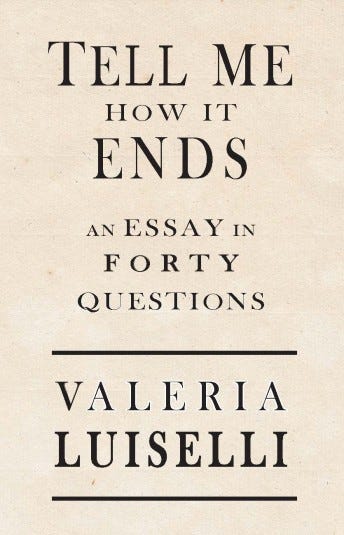
When I was ten, the girl next door told my three-year-old niece that they couldn’t play together because we were “aliens.” I didn’t understand the meaning behind calling a family of Guatemalan immigrants “aliens,” so at first I thought it was a funny case of miscommunication. Only once I saw how the adults responded did I learn the word’s xenophobic undertones.
I was reminded of this incident when I read Valeria Luiselli’s important new book Tell Me How It Ends: An Essay in Forty Questions, in which she describes her own history with the word. After she and her family send out their green card applications, they joke about their new status and whether they were “pending aliens” or “alien writers.” A few weeks later, they see news of plans filled with “alien” children about to be deported, which inspires her to take action and wonder “how concepts can erode so easily, how words we once used lightly can alchemize abruptly into something toxic.”
Horrified by the treatment the refugee children receive, she becomes a translator in New York’s immigration courts. As their translator, Luiselli must record each child’s answers to a series of questions. The first question is “Why did you come to the United States?” Contrary to popular narratives about economic opportunity, the book’s accounts reveal the far more common and urgent reasons for the children’s perilous migrations: they’re either searching for a parent or relative who’s already migrated, or they are fleeing “extreme violence, persecution and coercion by gangs, mental and physical abuse, forced labor, neglect, abandonment.”
She translates for a sixteen-year-old boy from Honduras, Manu López. Like those of many child refugees, Manu’s story involves the gangs Mara Salvatrucha 13 (MS-13) and the Barrio 18. After school one day, he and a friend were chased by members of Barrio 18. They ran, but the gangsters shot at them and killed Manu’s friend. Manu had filed a police report months earlier, and the police had done nothing, so this time he calls his aunt in New York and makes plans for escape.
Luiselli stresses that his story is more common than exceptional. Contrary to the talk of Dreamers, these children are survivors who come with “the more modest aspiration to wake up from the nightmare into which they are born.”

Luiselli supplements the children’s personal accounts with critical backstory on Central American migration. She explains that though they’re now rooted in Central America, both MS-13 and Barrio 18 originated in 1980’s Los Angeles. The original Barrio 18 members were second-generation Hispanics, and MS-13 emerged from El Salvadorian immigrants who fled their country because of the violence wrought by the country’s U.S.-backed dictatorship.
An anti-immigration crackdown in the ’90s deported thousands of gang members, but the deportations resulted in “more of a metastasis than an eradication,” and the gangs became transnational organizations with members in the United States, Mexico, Guatemala, El Salvador, and Honduras. The crackdown’s failure should have come as no surprise as it was less an anti-crime law than another effort in a longs campaign to demonize Central Americans.
As Douglas Massey and Karen Pren argue in their article on the unintended consequences of the 1965 immigration amendments, the villainization of Central Americans has been a fifty-year initiative. Emerging from the liberal mood of the time, the 1965 amendments were meant to remove the racist quotas that had been established in the 1920’s to limit immigration of Eastern European Jews and Polish Catholics and to bar the entry of Asians and Africans, but along with the abolition of these racist standards the new law changed policy on immigration from the Western Hemisphere.
Before the amendments, half-a-million people from Mexico could legally enter the U.S., either on a temporary work visa or as permanent residents, but in its fit of broadmindedness Congress chose to abolish rather than reform the exploitative workers program. Despite the loss of this program, the nearly half-million immigrants continued to enter the United States, but now the formerly law-abiding immigrants were labeled “illegals” and “criminals.”
Her attention on the individual [migrating] children, elevates the book beyond polemic and makes it into an important counterpoint to the dehumanizing accounts that trail the children.
The narrative of Latino criminals became a new sensation that both media outlets and politicians exploited. It led to increased border enforcement, which raised the number of apprehensions even as immigration remained constant. The increased apprehensions lent themselves to new narratives about “floods” and a besiegement of immigrants, and this vicious cycle primed the country for the ’90s crackdown Luiselli mentions and for the current policies that criminalize five-year-olds.
Along with her references to past wrongs, Luiselli examines the United States’ current complicity in Central America’s crime problem. Arms continue to travel in the opposite direction of migrants, and it’s the United States’ drug consumption that funds the cartel’s violence.
To escape the violence, the refugee children must court other dangers in their route to the United States. They pay exorbitant fees to cross with coyotes on a train across Mexico nicknamed La Bestia (The Beast). They ride in the spaces between railcars or atop their roofs, and thousands have died or been injured from the train ride alone. Among other dangers, they must also avoid smugglers, cartels, and corrupt law enforcement.
Luiselli recounts a story of a mass grave found in the Mexican desert with the bodies of seventy-two migrants, slaughtered by a cartel. She delivers the horrific figure that “eighty percent of the women and girls who cross Mexico to get to the U.S. border are raped on the way.” That this unimaginable violence doesn’t deter the children from the migration strikes against the argument that looser, more humane immigration policies would encourage more migrants to cross. The argument for more draconian immigration laws suggests its proponents believe they can outdo these risks, as if they could write laws whose brutality exceeds that of the cartels and rapists.
Once at the border, the children confront the United States’ convoluted and cynical legal system. Luiselli details her work with a pair of sisters from Guatemala. Five and seven years old, the girls must answer Luiselli’s questions, which will determine their eligibility for asylum. The girls answer in Spanish, their second language. Luiselli attempts to record their story, but the older girl answers many questions with “I don’t know” and gives confused responses to others.
The responses offer little help. Luiselli explains that “in the warped world of immigration, a correct answer is when, for example, a girl reveals that her father is an alcoholic who physically or sexually abused her, or when a boy reports that he received death threats or that he was beaten by several gang members.” Eventually children arrive before a judge, where they must plead guilty to having entered the United States without permission. At an age when most American kids are learning the alphabet, children like these girls are labelled criminals.
Though more direct than most, this label proves to be only one of many cues used to diminish the refugees’ humanity. Luiselli notes that phrases like “removing the illegal aliens” distract from the government’s culpability, and she singles out a New York Times article for its dehumanizing innuendoes of children “caught,” of a law that “allows” for their quick deportations, and of the “poor and violent” regions they come from. Instead of confronting the United States’ role in turning Central American towns into theatres of war, the article’s tone suggests the U.S. acts generously toward the children it portrays as “barbarians who deserve sub-human treatment.”
In this world of unending crisis, Luiselli’s book is an important testament to the people and children buried within the numbers and histories and politics, and through her compassionate observations she reminds us of their unassailable humanity.
Though Luiselli provides intelligent criticism of government policies and media coverage, her focus remains on the children she meets. Her attention on the individual children, elevates the book beyond polemic and makes it into an important counterpoint to the dehumanizing accounts that trail the children.
Luiselli’s relationships with the children are an admirable template of what it means to bear witness to another’s humanity. From the details she shares of her time with them, the children’s individuality emerges. She relays Manu’s dark humor when he loses his two front teeth after gang members beat him up in the U.S.: “Showing the wide gap and trying to joke about it, he says, I used to laugh at my grandma ’cause she had no front teeth, and now I look in the mirror and I laugh at me.” And when he’s named captain of a pick-up soccer team, she notes his visible pride from it.
With the sisters from Guatemala, she reveals the strange juxtaposition of adulthood and childhood that their situation makes for. The seven-year-old crosses her hands “as an adult might” when she answers the questions, but she answers with a touch of youthful naivety. She tries to correct Luiselli and tells her that a man brought them, not a coyote. She answers each question “with a big smile, toothless here and there” from the natural loss of baby teeth.
It’s old hat by now to find excuses for barring entry to people like Manu and the sisters. Whether they’ve fled famine, violence, persecution, or genocide, immigrants have often confronted resistance at this country’s borders. Today Syrian refugees are refused entry because people fear they might be terrorists, and Latin American children continue to be criminalized for fleeing their perilous homes. In this world of unending crisis, Luiselli’s book is an important testament to the people and children buried within the numbers and histories and politics, and through her compassionate observations she reminds us of their unassailable humanity.
Valeria Luiselli’s ‘Tell Me How It Ends’ Shows the Dreams and Nightmares of Refugees was originally published in DrunkenBoat on Medium, where people are continuing the conversation by highlighting and responding to this story.
